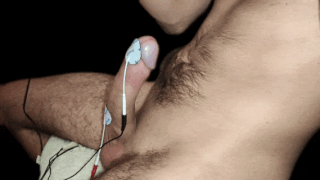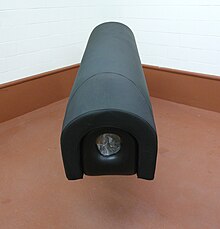Coitus interruptus, also known as withdrawal, pulling out or the pull-out method, is a method of birth control during penetrative sexual intercourse, whereby the penis is withdrawn from a vagina prior to ejaculation so that the ejaculate (semen) may be directed away from the vagina in an effort to avoid insemination.

Pre-ejaculate is a clear, colorless, viscous fluid that is emitted from the urethra of the penis during sexual arousal. It is similar in composition to semen but has distinct chemical differences. The presence of sperm in the fluid is variable from low to absent. Pre-ejaculate functions as a lubricant and an acid neutralizer.

Artificial insemination is the deliberate introduction of sperm into a female's cervix or uterine cavity for the purpose of achieving a pregnancy through in vivo fertilization by means other than sexual intercourse. It is a fertility treatment for humans, and is a common practice in animal breeding, including dairy cattle and pigs.
Insemination is the introduction of sperm into a female's reproductive system for the purpose of impregnating, also called fertilizing, the female for sexual reproduction. The sperm is introduced into the uterus of a mammal or the oviduct of an oviparous (egg-laying) animal. In mammals, insemination normally occurs during sexual intercourse or copulation, but insemination can take place in other ways, such as by artificial insemination.

Electroejaculation is a procedure used to obtain semen samples from sexually mature male mammals. The procedure is used for breeding programs and research purposes in various species, as well as in the treatment of ejaculatory dysfunction in human males. This procedure is used frequently with large mammals, particularly bulls and some domestic animals, as well as humans who have certain types of anejaculation. Electroejaculation has also been used for the cryoconservation of animal genetic resources, where semen is stored in low temperatures with the intent of conserving genetic material and future revival.

A sperm bank, semen bank, or cryobank is a facility or enterprise which purchases, stores and sells human semen. The semen is produced and sold by men who are known as sperm donors. The sperm is purchased by or for other persons for the purpose of achieving a pregnancy or pregnancies other than by a sexual partner. Sperm sold by a sperm donor is known as donor sperm.

Human reproduction is sexual reproduction that results in human fertilization to produce a human offspring. It typically involves sexual intercourse between a sexually mature human male and female. During sexual intercourse, the interaction between the male and female reproductive systems results in fertilization of the ovum by the sperm to form a zygote. These specialized reproductive cells are called gametes, which are created in a process called gametogenesis. While normal cells contain 46 chromosomes, gamete cells only contain 23 single chromosomes, and it is when these two cells merge into one zygote cell that genetic recombination occurs and the new zygote contains 23 chromosomes from each parent, giving it 46 chromosomes. The zygote then undergoes a defined development process that is known as human embryogenesis, and this starts the typical 9-month gestation period that is followed by childbirth. The fertilization of the ovum may be achieved by artificial insemination methods, which do not involve sexual intercourse. Assisted reproductive technology also exists.
Anejaculation is the pathological inability to ejaculate despite an erection in males, with (orgasmic) or without (anorgasmic) orgasm.

The northern white rhinoceros or northern white rhino is one of two subspecies of the white rhinoceros. Formerly found in several countries in East and Central Africa south of the Sahara, this subspecies is a grazer in grasslands and savanna woodlands. Since 19 March 2018, there are only two known rhinos of this subspecies left, called Najin and Fatu, both of which are female; barring the existence of unknown or misclassified male northern white rhinos elsewhere in Africa, this makes the subspecies functionally extinct. The two female rhinos belong to the Dvůr Králové Zoo in the Czech Republic but live in the Ol Pejeta Conservancy in Kenya and are protected round-the-clock by armed guards.
Robert Hermes is a veterinarian researcher at The Leibniz-Institute of Zoo and Wildlife Research in Berlin. He studied veterinary medicine at the Freie Universität Berlin. He completed a Ph.D. in reproductive management.

A semen analysis, also called seminogram or spermiogram, evaluates certain characteristics of a male's semen and the sperm contained therein. It is done to help evaluate male fertility, whether for those seeking pregnancy or verifying the success of vasectomy. Depending on the measurement method, just a few characteristics may be evaluated or many characteristics may be evaluated. Collection techniques and precise measurement method may influence results.
Semen quality is a measure of male fertility, a measure of the ability of sperm in semen to accomplish fertilization. Semen quality involves both sperm quantity and quality. Semen quality is a major factor for fertility.

In human anatomy, the penis is an external male intromittent organ that additionally serves as the urinary duct. The main parts are the root (radix); the body (corpus); and the epithelium of the penis including the shaft skin and the foreskin (prepuce) covering the glans penis. The body of the penis is made up of three columns of tissue: two corpora cavernosa on the dorsal side and corpus spongiosum between them on the ventral side. The human male urethra passes through the prostate gland, where it is joined by the ejaculatory duct, and then through the penis. The urethra traverses the corpus spongiosum, and its opening, the meatus, lies on the tip of the glans penis. It is a passage both for urination and ejaculation of semen.

Ejaculation is the discharge of semen from the male reproductive tract as a result of an orgasm. It is the final stage and natural objective of male sexual stimulation, and an essential component of natural conception. Ejaculation can occur spontaneously during sleep, and is a normal part of human sexual development. In rare cases, ejaculation occurs because of prostatic disease. Anejaculation is the condition of being unable to ejaculate. Ejaculation is usually very pleasurable for men; dysejaculation is an ejaculation that is painful or uncomfortable. Retrograde ejaculation is the condition where semen travels backwards into the bladder rather than out of the urethra.

An artificial vagina is a device designed to imitate the vagina as well as sometimes the vulva. To achieve this, it will generally be made of a soft material, lubricated, and occasionally heated.
A conception device is a medical device which is used to assist in the achievement of a pregnancy, often, but not always, by means other than sexual intercourse. This article deals exclusively with conception devices for human reproduction.
Vibroejaculation is a means of inducing ejaculation through vibration. It is used for semen collection, and in humans, the management of anejaculation.
Rebecca Spindler is the head of science and conservation at non-profit conservation organisation Bush Heritage Australia. She previously was the manager of research and conservation at Taronga Conservation Society Australia, in the New South Wales Office of Environment and Heritage (OEH).

Cryoconservation of animal genetic resources is a strategy wherein samples of animal genetic materials are preserved cryogenically.
Thomas B. Hildebrandt is a German veterinarian researcher dedicated to species conservation. He heads the Department of Reproduction Management at the Leibniz Institute for Zoo and Wildlife Research (IZW) in Berlin and holds a full professorship for Wildlife Reproduction Medicine at the veterinary faculty of the Freie Universität Berlin.












